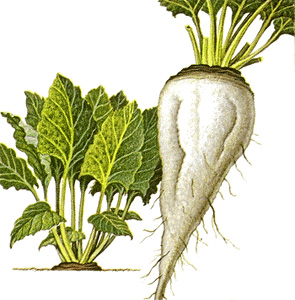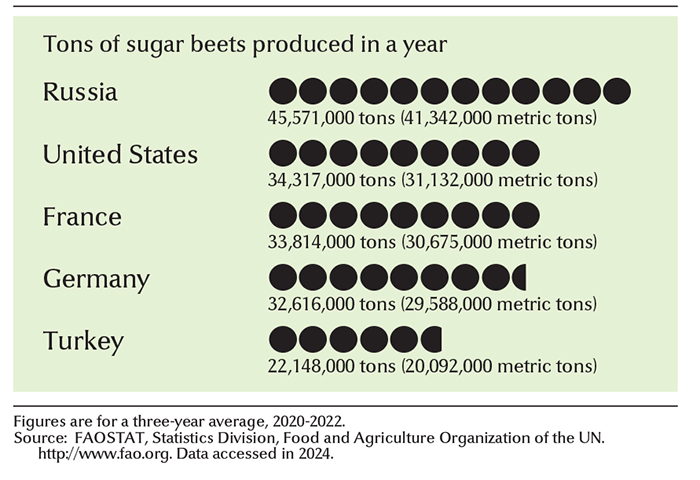Sugar beet is a plant grown for the sugar contained in its large, fleshy root. Sugar beets supply about 20 percent of the world’s commercial sugar. Only sugar cane provides more. Russia leads the countries of the world in growing sugar beets. Egypt, France, Germany, Poland, Turkey, and the United States are also important producers of sugar beets. In the United States, the chief beet-growing states include Idaho, Michigan, Minnesota, and North Dakota.

The sugar beet has a cluster of dark-green leaves atop a short stocky stem called the crown. Beneath the crown is the creamy-white, cone-shaped root. The enlarged upper part of the root is called the beet. The root tapers down to form a thin taproot, which extends 2 to 5 feet (0.6 to 1.5 meters) into the soil. The long taproot can obtain water that lies far belowground.
Sugar is produced in the plant’s leaves by photosynthesis and then transported to the root. The roots weigh from 11/2 to 3 pounds (0.7 to 1.4 kilograms). About 15 to 20 percent of this weight is a sugar called sucrose.
Raising sugar beets.
Sugar beets grow best in regions that have sunny days and cool nights. Farmers plant the seeds in early spring and apply fertilizer early in the growing season. Sugar beets require a large amount of water to prevent them from wilting, and in most growing areas, the plants are irrigated. 
Plants grown for sugar are harvested at the end of the first growing season, after the roots have developed. When grown for seed, the plants require a second year of growth. In areas that have mild winters, roots are simply left in the ground after the first growing season. In areas with cold winters, farmers dig up the roots in the autumn, store them over the winter, and then replant them in the spring. During the second year, the plants develop tall, branched stalks with tiny flowers that produce the seeds. In the United States, Oregon and Washington are the leading producers of sugar-beet seeds.
A number of diseases, insect pests, and nematodes (roundworms) attack sugar beets. Leaf spot and other fungal diseases are troublesome in regions with hot, humid summers. In areas with mild winters, sugar beets may be damaged by such viral diseases as curly top and beet yellows. During the winter, viruses that cause these diseases are found in various insects and weeds. In the spring, they are transmitted to sugar beets by such insects as aphids and leaf hoppers. Farmers control these diseases and pests by planting disease-resistant varieties of sugar-beet plants, by applying pesticides, and by using crop rotation.
Harvesting.
Sugar beets that are grown for sugar are harvested in late September or early October in most states, though California has a longer growing season. First, a plant is topped–that is, its leaves and crown are removed–and then its root is dug up. Both operations are done mechanically. The tops are fed to livestock or are used as fertilizer. The beets are shipped to a factory, where the sugar is extracted. For a detailed description of how sugar is obtained from sugar beets, and for the history of such production, see Sugar.
